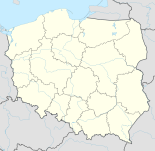Zabłocie (Żywiec)
| Zabłocie | ||
|---|---|---|
 Help on coat of arms |
|
|
| Basic data | ||
| State : | Poland | |
| Voivodeship : | Silesia | |
| Powiat : | Żywiec | |
| Gmina : | Żywiec | |
| Area : | 8.232 km² | |
| Geographic location : | 49 ° 41 ′ N , 19 ° 11 ′ E | |
| Residents : | 7700 (2006-12-31) | |
| Postal code : | 34-310 | |
| Telephone code : | (+48) 33 | |
| License plate : | SZY | |
Zabłocie is a district of Żywiec in the Silesian Voivodeship in Poland .
geography
Zabłocie is located in the Saybuscher Basin on the left bank of the Soła River .
Historically, Zabłocie had an area of around 609 hectares . The current district has 823.2 hectares.
history
The place probably originated in the late 14th century. In the Liber beneficiorum dioecesis Cracoviensis (1470-1480) of the historian and geographer Jan Długosz , the village in the districtus Zywyecz was mentioned as Zablocze, villa sub parochia ecclesiae de Zywyecz . The name, formerly also Zabłoć , is topographical and means [the place] behind mud ( za - behind , błoto - mud ).
Politically, the village originally belonged to the Duchy of Auschwitz , the feudal lordship of the Kingdom of Bohemia . The precincts of Zywiec with the village was pulled out in 1450 from the Duchy of Auschwitz. It finally belonged to Poland from 1465.
When Poland was first partitioned in 1772, the city became part of the new Kingdom of Galicia and Lodomeria of the Habsburg Empire (from 1804).
In the 19th century the village developed into a suburb of Saybusch, especially when the Second Imperial Road from Biała through Żywiec (with an iron bridge) to Nowy Sącz was built in 1820. In 1833 a paper mill was opened, and then in 1856 a brewery, today Żywiec Brewery . Since 1878 the Bielitz-Saybusch railway led to Zabłocie, later (1884) also the Galician Transversal Railway and the importance of the suburb continued to grow. The urban life of Saybusch for the most part moved in this direction (including the Saybusch Jews). In 1900 Zabłocie already had 337 houses with 2821 inhabitants, of which 2673 were Polish-speaking and 124 were German-speaking, 2384 of the residents were Roman Catholic, there were 390 Jews and 47 of other faiths. In 1910 Zabłocie already had 3487 inhabitants.
In 1918, after the end of the First World War and the collapse of the Austro-Hungarian monarchy, Zabłocie came to Poland. This was only interrupted by the occupation of Poland by the Wehrmacht in World War II . It then belonged to the district of Saybusch in the administrative district of Katowice in the province of Silesia (since 1941 province of Upper Silesia ).
During the Second World War, Zabłocie was incorporated into Saybusch for the first time, and finally in 1950.
Attractions
- Central station (built 1878)
- brewery
- Jewish cemetery (Żywiec)
Individual evidence
- ↑ a b c study uwarunkowań i kierunków zagospodarowania przestrzennego miasta Żywca. Część II: Kierunki rozwoju. 2010, pp. 65–66 , accessed on December 12, 2016 (Polish).
- ↑ a b Ludwig Patryn (ed): The results of the census of December 31, 1910 in Silesia , Opava 1912.
- ↑ Żywieckie Zabłocie. Opowieści z lewego brzegu Soły (CZ. I)
- ↑ Joannis Długosz Senioris Canonici Cracoviensis, "Liber Beneficiorum", Aleksander Przedziecki, Tom II, Kraków 1864, p. 289.
- ↑ Władysław Lubas: nazwy miejscowe Południowej części dawnego województwa Krakowskiego . Polska Akademia Nauk . Instytut Języka Polskiego, Wrocław 1968, p. 171 (Polish, online ).
- ^ Krzysztof Rafał Prokop: Księstwa oświęcimskie i zatorskie wobec Korony Polskiej w latach 1438-1513. Dzieje polityczne . PAU , Kraków 2002, ISBN 83-8885731-2 , p. 175-183 (Polish).
- ↑ General directory of the local parishes and towns in Austria based on the results of the census of December 31, 1910 . Hof- und Staatsdruckerei, Vienna 1915, p. 398.







